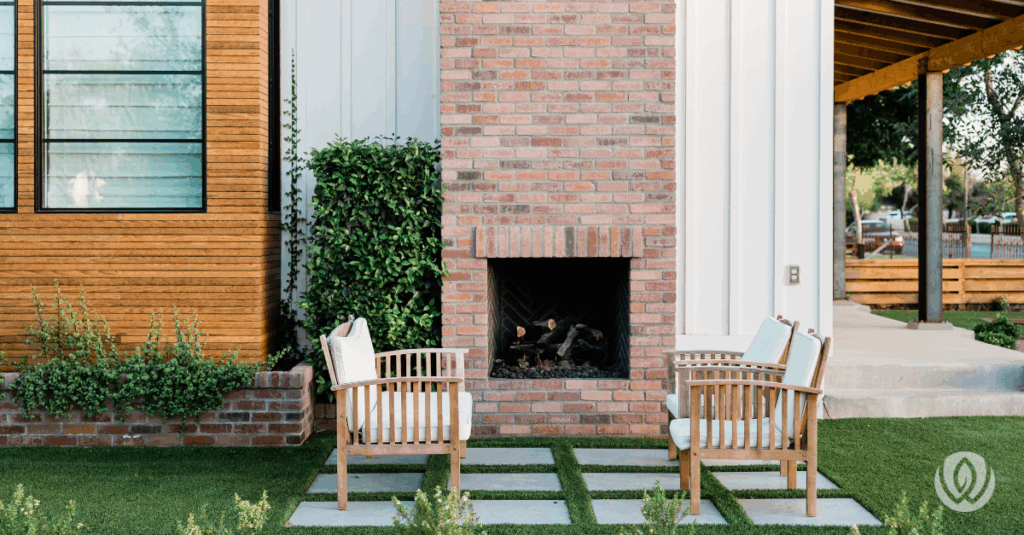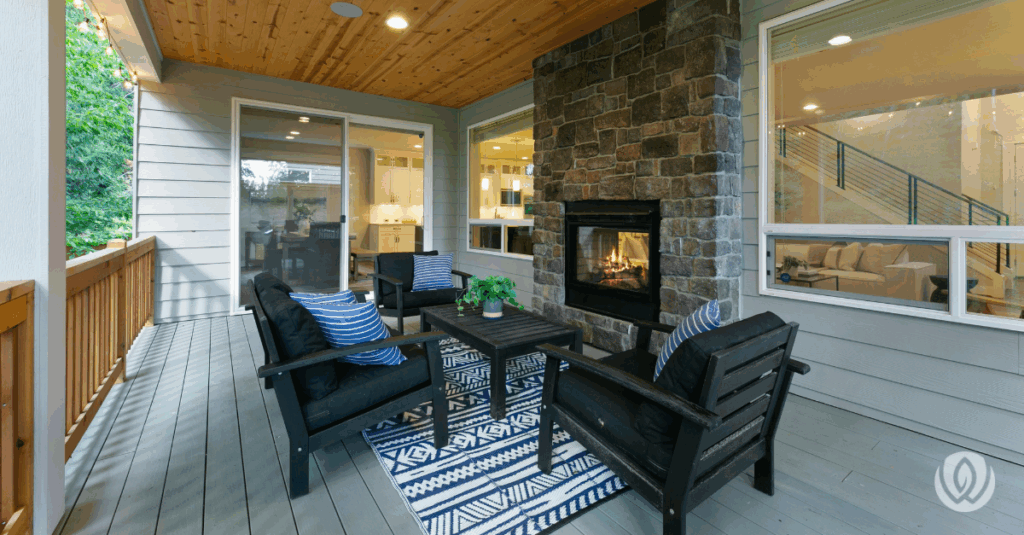
Imagine it’s a perfectly crisp evening and you’re out in your backyard laughing with friends. Wine is flowing, and the warm glow from a string of garden lights is setting the perfect atmosphere. The stars are twinkling, and the conversation is flowing. Wouldn’t it be a pity to have to end the party early just because it’s gotten too cold outside?
Sure, to ward off the chill, you could go out and buy a metal firepit or even build a lovely stone version on your patio. But for the truly elegant outdoor space, an outdoor fireplace is a must. It may seem like a big leap, but with a few tips about fireplace safety, you’ll be on your way to the patio fireplace of your dreams.

While firepits and chimeneas are a lovely addition to a yard, they both lack the impact and durability of an outdoor fireplace. Usually constructed of brick or stone, outdoor fireplaces mirror the look of a typical indoor fireplace.
Not only do they look charming, but you’ll also be able to enjoy your backyard sanctuary for much more of the year (in some places, all year long!) thanks to the warmth they provide.
You could choose a classic wood-burning option, gas, or even an electric model to truly capture effortless elegance. While wood-burning models require a bit more work than an outdoor gas fireplace, with some care, you’ll soon be enjoying the crackle and warmth of an evening fire with family and friends.
Just like building a fire indoors, an ounce of prevention is priceless when using an outdoor fireplace.
First, make sure the area around and above it has plenty of clearance from your house, patio, or any other nearby structures. Also, be sure to keep a fire extinguisher handy!
Did you know that in any fireplace, the type of wood you use matters? You’ll want to be sure the wood you burn is thoroughly dried or seasoned. Avoid softer woods like pine to keep your fireplace cleaner.
Also, steer clear of tossing things that aren’t actual fireplace wood onto your fires. Yard waste, cuttings, and garbage have no business in your fireplace.
And speaking of wood, make sure to trim any nearby trees and plants! This helps prevent unintentional fires. It also keeps plants from creeping into the stonework.
When plants or tree roots wriggle into your fireplace, cracks in your masonry can occur. Which brings us to our next point.

A small chip in the mortar of your fireplace may seem like a cosmetic nuisance, but failing to repair nicks and cracks turns a minor pain into a major problem. Flaws in the masonry work can allow water inside. This can result in decay and mold. In freezing temperatures, even more breakage occurs as ice expands into the stonework.
Be sure to use refractory mortar in areas exposed to high heat, and don’t forget to apply a waterproofing sealant annually.
Just like an indoor wood-burning fireplace, you’ll want to clean your patio or porch fireplace after each use. It’s a safety precaution, but it also keeps ashes from blowing around your yard and prevents soot stains from marring your fireplace.
Once your fire is totally out and the wood is cool to the touch, remove all remaining wood and use a fireplace brush and shovel to sweep it out. If pesky, fine particles remain, grab a shop vac to clean them out.
While the cast iron grate that holds your firewood is incredibly durable, for proper maintenance, it should be cleaned a few times per year. You’ll want to be sure to do this away from your patio or any furniture you’d like to keep clean.
Using a wire brush, simply scrub off accumulated soot and rinse with a hose (high pressure is best). For the best results, season your grate with some cast iron oil. Be sure to wear clothes you don’t care about, and don’t forget your rubber gloves!
Just like in the home, chimney fires are a risk in outdoor chimneys as well. If you use your outdoor fireplace frequently, clean the chimney every year.
You can always hire a pro to do this for you, or you can do it yourself. For shorter, outdoor chimneys, the DIY way is often sufficient if properly done.

The firebox is the interior area that houses the actual fire. Most commonly, it’s made of refractory panels or a stainless steel insert. Over time, exposure to intense heat can cause it to crack or warp.
Be sure to inspect your firebox once a season, at least, and replace it when it begins to show signs of wear and tear.
As you probably know, an outdoor gas fireplace comes equipped with ceramic logs (just like an indoor fireplace). Sure, they look cute, but they’re also designed to retain heat and allow for gas to pass through them safely. Like any other component of your fireplace, they need to be cleaned regularly.
However, it’s crucial they’re put back to the specific assembly specs in which they came once you’ve finished your fireplace maintenance. You may want to document the process of disassembling them to be sure they’re replaced correctly.
Similarly, when cleaning any fireplace media, like the fire-glass or stones in linear gas fireplaces, only use materials approved by the manufacturer and adhere to the instructions.
Ready to enjoy your backyard oasis both day and night? At LiveWell Outdoors, we specialize in complete backyard transformations that bring your entire outdoor space to life.
From luxury patios to pools and outdoor kitchens, we’ll help you design a space that reflects your lifestyle and gives you more reasons to step outside.
Schedule a consultation today, and let’s create the cozy outdoor retreat of your dreams.
